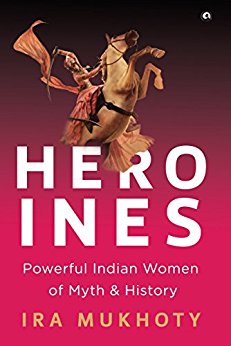
Heroines by Ira Mukhoty takes 8 women from Indian history – women we have always celebrated as empowered women. You would know all these women even if you have not sat down to study them like Ira Mukhoty. They belong to pages of history or poetry or epics that form the fabric of our cultural past. What can a new age author tell more about these women? Some of them have books and books written on them. One of them is immortalized by an epic poem written on her while the other famous for the poetry she wrote. Well, you can see their journeys through the lens of this age women.
You can see the resonance of your journeys in their journeys. Believe me, there is a lot of resonance in each of their stories – even in the embellished versions that we have access to. This is exactly Ira Mukhoty does in this book that she chooses to call – Heroines.
She chooses Draupadi and Radha who many consider mythology and many consider historical. For me, Draupadi is certainly historical but Radha I am not too sure. She chooses fighters like Rani Laxmibai of Jhansi and Raziya Sultan of Delhi. Then she chooses the poetess saint Mira Bai whose story defies so many established norms of the Rajputana. She then has royal women who held quite a unique position in the society – like Ambapali of Vaishali in 6th BCE. She was a Ganika or a courtesan who would give up everything to become a nun in a Buddhist Monastery.
Then there is Jahanara Begum – Shah Jahan’s daughter who would remain a daughter and a sister. But yet carve a niche for herself as one of the richest women the history has ever seen. There is Hazrat Mahal of Lucknow – a divorcee in 19th CE who refuses to give up and keeps fighting for the rights of her son.
I like the first chapter a lot – on Draupadi. Maybe it is the personality of Draupadi – her rage and resolve or the sheer rasa in her story, that despite being familiar with every aspect of the story, you still enjoy it. Ira Mukhoty has also done just to the analysis she has given to Draupadi. I enjoyed reading the chapter – it was like listening from a friend about an acquaintance.
I was really keen to read about Radha. Because of the limited material available on her. Remembered my visit to Barsana where Radha came from and where she is celebrated as Kishori – the eternal adolescent. I have been trying to find books on her. But I guess all authors face the same roadblock – a paucity of base material on Radha and her relatively small appearance in the story of Krishna. She has no independent story of her own., But her story stands independent of every other character barring Krishna.
In Braj Bhumi – she rules, her name is everything there. I liked the way Ira Mukhoty brought our Radha’s relationship with Jungle – that is pretty much her playground, her love nest while for most other heroines it is a kind of punishment when they go to the jungles. There is a lot of poetry in this chapter – as you would expect in anything that describes Radha.
The story of Ambapali primarily comes from the book – Vaishali ki Nagarvadhu. I read that book just before I visited Vaishali in Bihar. Her story is enchanting – of a woman of no known origin, of a woman who is all about prosperity. And a woman with power in her hands without really owning it. The chapter is nice but I agree with Ira Mukhoty on one place – where she refers to Ambapali as ‘Upstart Courtesan, the Mango Woman’. When she invited Buddha she was at the peak of her career. Mango Woman – just bad editing.
The story of Razia Sultan made me think if Delhi is a place that has seen most women rulers? I visited Razia Sultan’s grave near Turkman Gate in Delhi a few years ago. And I wish these writings on her would lead the government to revive them as monuments. Similarly while reading the chapter of Jahanara I could sense the Chandni Chowk she built. I have sat next to her grave at Nizamuddin Dargah, so it was nice to revisit Delhi & Agra through her story. Incidentally, I heard Hazrat Mahal’s story recently in Lucknow – interesting story.
Mira Bai’s is an enigma. She would remain so. We know the story that has been passed on to us and we know the story of the family she was married into. At Chittorgarh when I sat at her temple, I did not feel any devotion but then I must remember this is a place that has seen the kind of violence that not many forts have. In a place that is best known for Jauhar done thousands of women there lived a woman who was all about Bhakti, Devotion, Music & Dance. The fact that she could do all that she did really make us question the documented history of women of that region. The Ira Mukhoty’s rendition of Mira Bai’s story is interesting too. I wish there was better editing – at a place, it says disaffection when it should be detachment.
You may buy this book Heroines by Ira Mukhoty at Amazon.
Overall, an interesting read, especially if the history of women interested you.
Read it.









Anu,it was very nice to read about these powerful women,but you have not mentioned any thing about Jhansi Laxmi Bai…..(from the book)
Hi Sarita, I did mention her in the introduction.